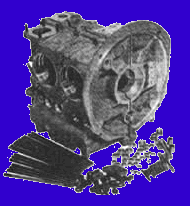|
| |


There are many crankcases available, your original case, a
new original case, a clearanced case and race cases, they are all good for what
they were built for. If you intend to keep your original case and want anything
over 75BHP you should only do this if it is a twin port, that is one whose
serial number begins with two alpha characters from AB to AS. They should also
have the part number AS21 or AS41 (this is on the side under the pushrod tubes).
Apparently the AS21, produced after the AS41, has a greater aluminum to
magnesium ratio than the AS41 and therefore handles heat better, although this
guy never had any trouble with an AB 1300 case (AS41) up to 180BHP, but he has
never used one long term on the road. Gene Berg has done much work looking into
the differences and advocates the use of AS21 rather than AS41, but this guy
have not found any noticeable difference.
Old or new? A lot of people feel the need to align bore a case just out of
habit, but this guy feels this is not really necessary. If you journals are in
need of machining, then yes, machine them, otherwise leave well alone. Take the
case to a machine shop and ask them. Also get them to check the flywheel thrust
face, this will probably not be obvious until you go to set the endfloat and
find it is several millimeters instead of just fraction of one. A new case is
the best way to go, but on a budget this is not always easy. You can buy
reconditioned cases, but personally this guy says no, don't.
Case studs were also changed from about 1975 for 8mm rather than 10mm. The
reason for this is that the 10mm studs stretch once heated more than the 8mm,
once again this guy never experienced any trouble with the larger studs. One
advantage to the 8mm studs is that they already have case saver inserts fitted.
It is possible to obtain case savers, these are stud sleeves, which requires the
case being tapped to 12mm or 14mm where the old studs went, then inserting the
case savers, then the 8mm or 10mm studs go into them. Be warned, if you plan to
open the case up for 94mm cylinders you will experience trouble with the inserts
encroaching in the holes, and remember a steel insert will not bore anything
like as easily as the mag/alloy case, in fact it will probably destroy the
cutting tool.
The next case up is a clearanced case, these have been machined for 90.5/92mm
cylinders and the insides have been opened up to accept an 84mm crankshaft.
These cases are very good value for money when you consider the cost of a new
universal case and then the machining costs. These cases often have the oil
gallery bored to allow the insertion of an external oil filter, which is useful
and will save a few quid getting it done later (by the way, these are this guys’
favourite choice of case).
Race cases come from the top names, Autocraft, Bugpack, Pauter, Rimco and Scat,
but they aren't cheap. Use one only if you feel you really have to, or you're a
chap I know who won't buy what will do the job, he has to have the most
expensive. They are, however, very strong, sometimes heavier than a standard
case, but really not necessary for a road going 150bhp engine. Put the money
into something that will make your car go faster, you'll feel better doing that.
|




![]()